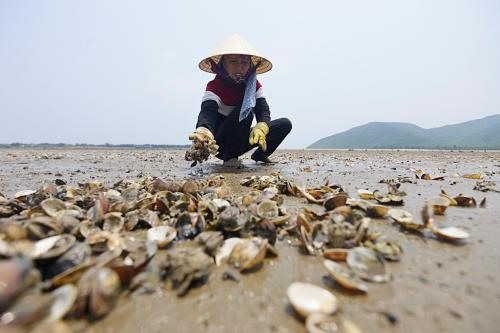 Environment
Environment

Sea water and waste water samples related to mass clam deaths in central Thanh Hóa Province have failed to meet environment criteria, said Lê Văn Bình, head of the Environmental Protection Branch under the provincial Department of Natural Resources and Environment, on Sunday.
 |
| Clams die en mass in Thanh Hóa Province. – VNA/VNS Photo |
THANH HÓA — Sea water and wastewater samples related to mass clam deaths in central Thanh Hóa Province have failed to meet environment criteria, said Lê Văn Bình, head of the Environmental Protection Branch under the provincial Department of Natural Resources and Environment, on Sunday.
All the samples’ quality criteria exceeded the permissible level, with some exceeding by thousands of times.
According to Thanh Hóa Province’s Department of Agriculture and Rural Development, clams reportedly died en mass in the communes of Hải Lộc and Đa Lộc in Hậu Lộc District and Hoằng Trường Commune in Hoằng Hóa District since December 19, 2016.
The highest number of dead clams was recorded in three days from December 21 to 23.
Clams continue to reportedly die in some places.
According to the report, up to 70 per cent of the clams in 201 out of 230ha died in Hải Lộc Commune.
In Đa Lộc Commune, 120 out of 250ha reported 30 to 70 per cent of dead clams. Some 80ha had 70 per cent of dead clams.
In Hoàng Trường Commune, all 12 out of 12ha had the clam death rate standing at 15 to 40 per cent.
Disease was eliminated as a reason for the clam deaths following a test result of the National Animal Health Diagnostic Centre. It showed clams did not die of Perkinsus, a parasitic infection that poses fatal danger to clams.
On December 31, 2016, a couple, Hoàng Văn Thành and Hoàng Thị Huệ, were caught red handed discharging waste from eleven plastic barrels, 50 litres each, at the clam breeding area in Hải Lộc Commune.
The waste was liquid from washing aquatic products and seafood processing. According to the test result of the provincial Department of Natural Resources and Environment, biochemical oxygen demand 5 (BOD 5) in waste sample was higher than the standard 1,500 to 1,900 times.
BOD 5 is the amount of dissolved oxygen needed by aerobic biological organisms to break down organic material present in a given water sample in five days at the temperature of 20 degree Celcius.
Chemical Oxygen Demand (COD), the amount of oxygen needed to oxidise chemical compounds in water, both organic and inorganic, was higher than the permitted level of 600 to 800 times.
Cadmium, an extremely toxic metal, exceeded permitted level by over 1,500 times.
Investigation to find whether the clam deaths were caused by the waste released by the couple is being undertaken by police of Hậu Lộc District and Thanh Hóa Province’s environmental police. — VNS




